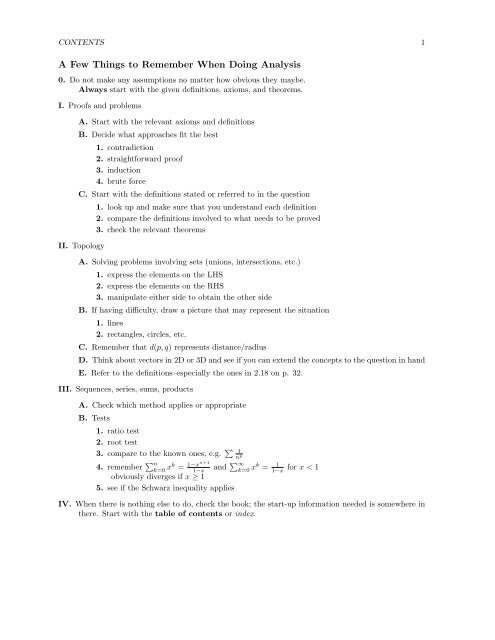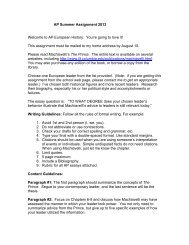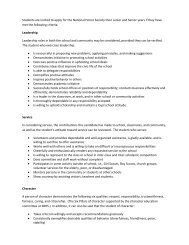Studying Rudin's Principles of Mathematical Analysis Through ...
Studying Rudin's Principles of Mathematical Analysis Through ...
Studying Rudin's Principles of Mathematical Analysis Through ...
Create successful ePaper yourself
Turn your PDF publications into a flip-book with our unique Google optimized e-Paper software.
CONTENTS 1<br />
A Few Things to Remember When Doing <strong>Analysis</strong><br />
0. Do not make any assumptions no matter how obvious they maybe.<br />
Always start with the given definitions, axioms, and theorems.<br />
I. Pro<strong>of</strong>s and problems<br />
A. Start with the relevant axioms and definitions<br />
B. Decide what approaches fit the best<br />
1. contradiction<br />
2. straightforward pro<strong>of</strong><br />
3. induction<br />
4. brute force<br />
C. Start with the definitions stated or referred to in the question<br />
II. Topology<br />
1. look up and make sure that you understand each definition<br />
2. compare the definitions involved to what needs to be proved<br />
3. check the relevant theorems<br />
A. Solving problems involving sets (unions, intersections, etc.)<br />
1. express the elements on the LHS<br />
2. express the elements on the RHS<br />
3. manipulate either side to obtain the other side<br />
B. If having difficulty, draw a picture that may represent the situation<br />
1. lines<br />
2. rectangles, circles, etc.<br />
C. Remember that d(p, q) represents distance/radius<br />
D. Think about vectors in 2D or 3D and see if you can extend the concepts to the question in hand<br />
E. Refer to the definitions–especially the ones in 2.18 on p. 32.<br />
III. Sequences, series, sums, products<br />
A. Check which method applies or appropriate<br />
B. Tests<br />
1. ratio test<br />
2. root test<br />
3. compare to the known ones, e.g. ∑ 1<br />
n p<br />
4. remember ∑ n<br />
k=0 xk = 1−xn+1<br />
1−x<br />
obviously diverges if x ≥ 1<br />
5. see if the Schwarz inequality applies<br />
and ∑ ∞<br />
k=0 xk = 1<br />
1−x for x < 1<br />
IV. When there is nothing else to do, check the book; the start-up information needed is somewhere in<br />
there. Start with the table <strong>of</strong> contents or index.

















